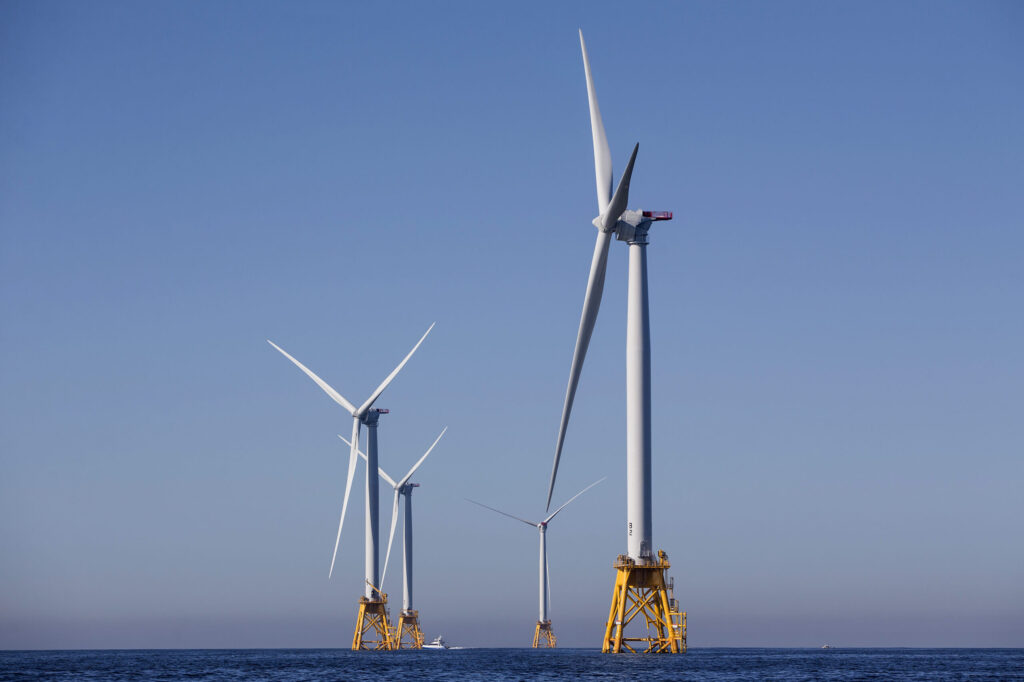Winning a bid, BOEM said, “does not authorize the construction and operations of an offshore wind facility.” Here, the Block Island wind farm off of Rhode Island. (Scott Eisen | Getty Images)
The Bureau of Ocean Energy Management will hold an auction for offshore wind leases in the Gulf of Maine in late October, it announced Monday.
Eight lease areas off the shores of New Hampshire, Massachusetts, and Maine are up for grabs. These lease areas were reduced by 12 percent – or more than 116,000 acres – from the proposed sale notice, issued in April, in response to concerns from interests including the fishing industry, BOEM said in its final sale notice set to be published in the Federal Register on Tuesday.
Winning a bid “does not authorize the construction and operations of an offshore wind facility,” BOEM said in a news release Monday. Instead, that bidder can then submit “project-specific plans,” which will be subject to “environmental, technical, and public reviews” before BOEM decides whether to approve it, the bureau said.
Developing offshore wind in the Gulf of Maine has been a political debate in New Hampshire. Republican Gov. Chris Sununu has embraced the energy opportunity, while his pick to replace him, former U.S. Sen. Kelly Ayotte, has said she doesn’t think the projects are right for the state. Democratic candidate Joyce Craig, the former Manchester mayor, is for them.
The projects would be a huge boon to the region’s renewable energy capabilities – enough to power more than 4.5 million homes, BOEM said. At the same time, they’ve faced bitter opposition from many local fishermen, a crowd of whom voiced their disapproval of the project at a May public meeting held by BOEM in Portsmouth.
In its final sale notice, BOEM laid out how it shaped the lease areas in response to feedback from various stakeholders. It received 262 public comments on its proposed sale notice, it said.
To avoid sensitive habitats, BOEM said it removed portions of four lease areas. And following data analyses and public engagement around fishing activity, it removed parts of seven lease areas. Other considerations were made for vessel transit, it said.
BOEM said it removed “from current leasing consideration several areas that overlap with a combination of offshore fishing activity, vessel transit, seafloor features” identified by the National Marine Fisheries Service to be “potentially sensitive,” and areas of “relatively higher densities of North Atlantic right whale sightings and detections.”
Now, the proposal to capture the energy capabilities of this area of the North Atlantic Ocean enters its next phase.
To participate in the auction, bidders must take several steps, including submitting financial forms to BOEM by Sept. 27 and a $2 million deposit for each lease area sought, with a maximum of two per bidder, by Oct. 11. There are two lease areas in what BOEM has designated as the north region of the ocean area and six in the south region; accordingly, bidders may vie for a maximum of one lease in the north plus one in the south or two in the south.
On Oct. 24, BOEM will hold a “mock auction,” open only to qualified bidders who have met the bureau’s requirements and deadlines. This is an opportunity for bidders “to clarify auction rules, test the functionality of the auction software, and identify any potential issues that may arise during the auction,” BOEM said.
Then, at 9 a.m. on Oct. 29, the real auction will commence, with the minimum bid starting at $50 an acre, the equivalent of between $4.8 million to $6.2 million per lease area. Provisional winners will be announced at the end of the process, which is expected to last one or two business days, according to BOEM. Then, the bidders that didn’t win get their deposits back, plus an explanation of why they didn’t win, and the Department of Justice gets 30 days to conduct an antitrust review of the auction.
After that, BOEM sends three lease copies to each provisional winner, who have 10 days to sign them, post financial assurances, and pay the outstanding balance of their winning bid.
Lessees must pay the first year of rent within 45 days, which is $3 per acre. Acreage for the lease areas ranges between just over 96,000 acres to almost 125,000 acres, which puts rent between around $288,000 and almost $375,000 per year until commercial operation starts, after which rent is charged only for undeveloped acreage, BOEM said.

